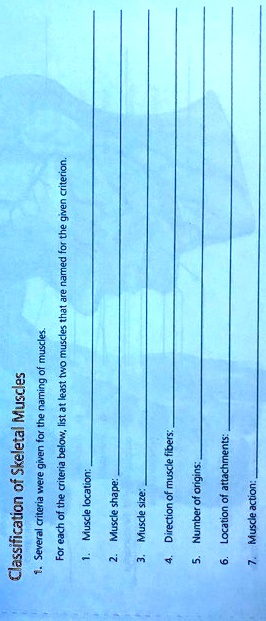Classification of Skeletal Muscles 1. Several criteria were given for the naming of muscles. For each of the criteria below, list at least two muscles that are named for the given criterion. 1. Muscle location: 2. Muscle shape: 3. Muscle size: 4. Direction of muscle fibers: 5. Number of origins: 6. Location of attachments: 7. Muscle action:

The Correct Answer and Explanation is:
- Muscle location
- Brachialis
- Temporalis
- Muscle shape
- Deltoid
- Trapezius
- Muscle size
- Gluteus maximus
- Gluteus minimus
- Direction of muscle fibers
- Rectus abdominis
- External oblique
- Number of origins
- Biceps brachii
- Triceps brachii
- Location of attachments
- Sternocleidomastoid
- Iliocostalis
- Muscle action
- Flexor digitorum
- Extensor carpi radialis
Skeletal muscles are named through a variety of descriptive criteria that highlight specific anatomical and functional features. These naming conventions aid students and health professionals in identifying muscles based on their visible or structural traits. Muscles may be named by location, such as the brachialis located in the arm or the temporalis over the temporal bone. Others reflect their shape, like the deltoid which resembles a triangle and the trapezius with its trapezoidal contour.
Size distinctions also guide naming, as in the case of gluteus maximus, the largest gluteal muscle, and gluteus minimus, the smallest. The direction of fibers adds another layer of detail. For example, rectus abdominis runs vertically while the external oblique angles across the abdomen.
Muscles often indicate the number of origins, or heads, such as biceps brachii with two and triceps brachii with three. Their attachments may also influence their names, like sternocleidomastoid, which links the sternum, clavicle, and mastoid process. Lastly, muscle action provides functional insight. For instance, flexor digitorum flexes the fingers and extensor carpi radialis assists in wrist extension.
This classification system bridges structure and function, giving meaningful insight into muscle roles and relationships in the body.
